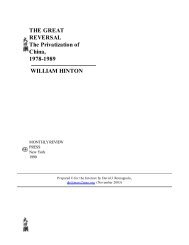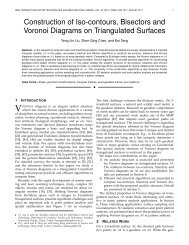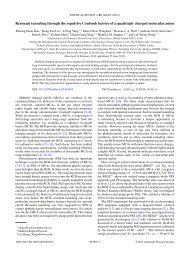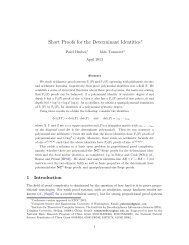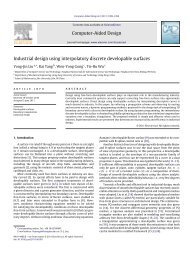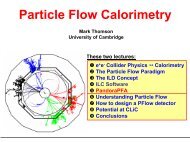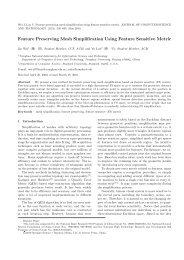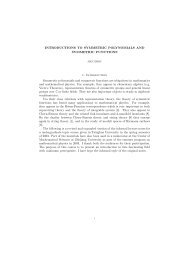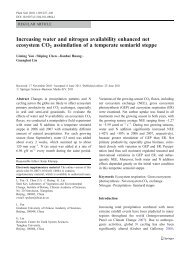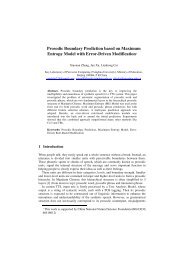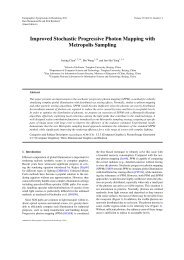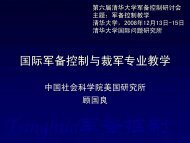Whistle: Synchronization-Free TDOA for Localization - ResearchGate
Whistle: Synchronization-Free TDOA for Localization - ResearchGate
Whistle: Synchronization-Free TDOA for Localization - ResearchGate
You also want an ePaper? Increase the reach of your titles
YUMPU automatically turns print PDFs into web optimized ePapers that Google loves.
an ARM processor, a sensor array, a wireless radioconnector, and precise self-calibration of array positionand orientation.An energy-based localization system is proposed in[4], in which the positions of speakers are estimatedusing an ad hoc microphone array setting and themaximum likelihood estimation method. In [21], aset of methods based on energy measurement aredeveloped, compared, and contrasted. Particularly, aweighted direct least-squares <strong>for</strong>mulation is presented,which incorporates the dependence of unknown parametersleading to high per<strong>for</strong>mance.BeepBeep [23] is an acoustic-based ranging systemwith high accuracy. It measures the distance of twocell phones using only their microphones, speakers,and WiFi connection, without leveraging any preplannedinfrastructure. In BeepBeep ranging system,two cell phones emit the same sound signal (Beep)successively, then each phone computes the elapsedtime between the two time-of-arrivals (ETOA). Withthe two ETOAs, the distance between the two phonescan be obtained. Both the two nodes of BeepBeepmust actively participate the ranging process, so thescheme of BeepBeep can be used <strong>for</strong> TOA localization,but not <strong>for</strong> <strong>TDOA</strong> inherently because the to-be-locatedobject (or event) does not necessarily cooperate withreceivers. <strong>Whistle</strong> extends BeepBeep and develops newtechniques <strong>for</strong> <strong>TDOA</strong> localization.Though range-based localization methods can gethigh accuracy, they often need expensive equipmentsand have strict connectivity requirements. Some classicrange-free algorithms like DV-hop [5] and APIT [30]are proposed to implement localization in more extensivecircumstances. DV-hop uses the average distanceof each hop and hop counts to calculate the realdistance between two nodes, so DV-hop has betterper<strong>for</strong>mance in isotropic WSNs. APIT makes tests toknow whether the unknown node is inside the triangle<strong>for</strong>med by different anchor nodes, and obtains theintersected region of all the triangles that cover theunknown node, then sets the centroid of that regionas the result. APIT has high accuracy but has strictrequirements <strong>for</strong> connectivity. Mo Li et al. [17] revealthat these range-free schemes fail in anisotropic WSNswith possible holes, and propose the Rendered Path(REP) protocol that is the only protocol <strong>for</strong> locatingsensors with constant number of seeds in anisotropicWSNs.Several techniques have been proposed <strong>for</strong> solvingnon-linear <strong>TDOA</strong> equations. Fang [7] reducedthe computation to the solution of a quadratic or aquartic equation, but his method can not make use ofextra measurements from extra receivers to improveposition accuracy. More general methods with extrareceivers can be found in [10], [28]. They provideclosed-<strong>for</strong>m solutions, but their estimators are not unbiasedand optimum. Abel [13] proposes a divide andconquer (DAC) method which can achieve optimumper<strong>for</strong>mance and unbiased estimator when the datavector is appropriately subdivided, but DAC requiresquiet large Fisher in<strong>for</strong>mation and is difficult to beimplemented. The Taylor-series method [31], [8] canget high accuracy at reasonable noise levels, but itis computationally intensive because of its iterativecourse and finding a proper initial point to avoidthe convergence problems is not easy. The methodproposed by Chan [33] is noniterative and gives anexplicit solution, and attains the Cramer-Rao lowerbound near the small error region. This method alsohas a higher noise threshold than DAC. In short,the method balances computational complexity andaccuracy, and is accordingly adopted in our work.6. ConclusionIn this paper, we propose an acoustic source localizationframework, <strong>Whistle</strong>. As a <strong>TDOA</strong> based system,<strong>Whistle</strong> changes the scheme of <strong>TDOA</strong> fundamentally,by releasing the synchronization. In <strong>Whistle</strong>, severalasynchronous receivers record a target signal and asystem signal. High time resolution is achieved throughtwo-signal sensing and sample counting. Real-worldexperiments are conducted on a testbed system consistingof COTS cell phones. Experiment results show that<strong>Whistle</strong> has a mean location error of 10∼20 centimetersin a 9×9×4m 3 3D space. To summarize, <strong>Whistle</strong>achieves low cost, rapid deployment, and widespreaduse simultaneously.Our ongoing work are: (1) extending <strong>Whistle</strong> <strong>for</strong>larger wireless sensor networks, in which a largenumber of nodes are organized in an ad-hoc manner.There may be quite a lot new problems including errorcontrol and localizability [36] in this multi-hop WSN.Besides, we may have to construct a self-adaptiveWSN topology like [16], <strong>for</strong> some nodes may run outof energy earlier than the other. Finally, we shouldpay particular attention to the factors that restrict theWSN’s scale and lifetime proposed by Yuan He etal. [34] ; (2) trying to use ordinary sound or voice insteadof a signal that can be mathematically described,and see if we can find some new method <strong>for</strong> detectingits arrival accurately. (3) using RF signal instead ofacoustic signal. UWB signal is our first choice, as itoffers high time resolution. We will implement <strong>Whistle</strong>on a UWB localization system and see its effects.



